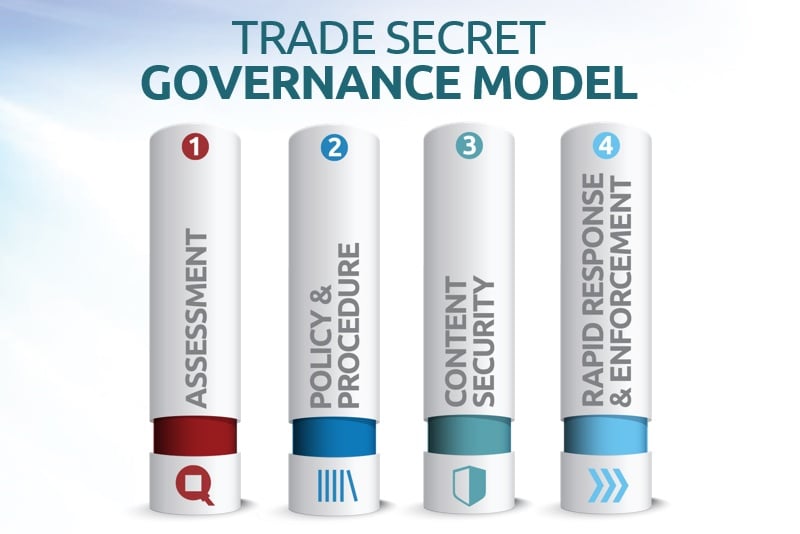
Trade Secret Governance: Assessing Trade Secrets
The Trade Secret Governance Model
While most organizations are diligent in carefully registering, cataloging and monitoring their tangible intellectual property of patent, trademarks and copyrights, the most valuable asset of them all often remains elusive: Trade Secrets. A study by Forrester Consulting found that fully two-thirds of an organization’s information portfolio can be attributed to trade secrets and in knowledge-intensive fields, this number rises to 70 and even 80%.
Previously the term “Trade Secret” was defined by the Uniform Trade Secrets Act (UTSA) as “information, including a formula, pattern, compilation, program, device, method, technique, or process” but in 2016 with the passage of the Defense of Trade Secrets Act (DTSA), that definition was expanded to
"All forms and types of financial, business, scientific, technical, economic, or engineering information,” including “patterns, plans, compilations, program devices, formulas, designs, prototypes, methods, techniques, processes, procedures, programs, or codes.”
With this new federal framework, a much wider net was cast to formally (and federally) categorize “business know how” as a protectable trade secret.
The many forms of “know how”
There are no subject matter constraints imposed on trade secret protection so long as the information provides a competitive advantage derived from the secrecy of the information.
Both technical and nontechnical information can be protected.
- PRODUCT INFORMATION: New Hardware designs; adaptations/updates of existing products
- RESEARCH & DEVELOPMENT: Long-term R&D; basic or applied research; geology R&D
- CRITICAL & UNIQUE BUSINESS PROCESSES: Inventory/distribution manufacturing processes; business model based on application of processes
- SENSITIVE BUSINESS INFORMATION: M&A prospects/plans’; market research/studies; customer list/information; information on key suppliers/business partners; expansion plans; corporate strategy
- IT SYSTEMS & APPLICATIONS: Novel applications of IT that could create new markets; system architecture designs; source code; algorithms
Novelty is not required for trade secret protection. Usefulness is not required for trade secret protection; in fact, even negative know-how (what doesn’t work) is protectable as a trade secret. Instead, the trade secret analysis is constrained only by the difficulty to reverse engineer the trade secret.
BEYOND RESEARCH AND DEVELOPMENT
Business know-how is ingrained in every aspect of business operations and all of it is as valuable as it is protectable. It is important that companies assess and inventory their trade secrets broadly, and not confine their analysis merely to products, services and brands.
Competitive business know-how must be evaluated within the context of every functional area at every level, from the strategy decisions of senior leadership to the operational processes of front line managers.
Subject matter experts in areas such as Legal, Information Technology and Marketing all create and deliver a wealth of trade secret information throughout their specialized operations.
The full assessment of intangible intellectual property is not limited only to internal employees. Outside entities such as retained legal counsel, 3rd party consultants, and vendors must be considered, including the relationships and processes used to initiate and govern those engagements. Even clients and customers themselves can be have knowledge of or even be contributing parties to protectable trade secret information.
And of course, any formal Research and Development department must operate under a strict protocol of safeguarding proprietary knowledge. But even here, where it should be most obvious, the emphasis is often disproportionately focused on the end results and the discrete iterations of finished products.
Instead this knowledge-rich area of the enterprise should be viewed holistically to encompass the entire creative environment with all of the methods, procedures and techniques that go into end-to-end innovation.
The Content Universe is Vast
Once all of these centers and silos of proprietary business know-how are recognized as true owners and custodians of trade secret information, the next challenge is identifying where this knowledge physically lives and how to protect it.
The most obvious, and easiest to safeguard, are the structured technical repositories of data: source code libraries, sales and marketing databases, engineering file servers, etc.
But content is ubiquitous and no trade secret is less valuable simply because it is not as articulated as a secret formula or breakthrough chemical compound. Things like communication threads, org charts, project documentation, collaboration notes, marketing pitches and even rejected initiatives are all proprietary investments of the organization.
This kind of operational collateral can be generated from or stored in any number of formats and places from formal business data systems to email and mobile devices to simple hand-written pieces of paper.
READ THE CASE STUDY |
 CASE STUDY:
CASE STUDY:
KFC 11 Herbs and Spices
DATE: August 2016
Unbeknownst to KFC or their parent company, a nephew of the brand’s iconic founder allowed a journalist to publish a picture of a hand-written copy of the famous “11 herbs and spices” recipe that was written on the back of the original will of Colonel Sander’s second wife.
This recipe is often described as one of the most famous US business trade secrets, routinely cited by the company’s own marketing and branding efforts and touted as something the company goes to great lengths to secure (the recipe is locked in a digital safe under 24-hour surveillance and only known by key executives on a need-to-know basis).
The failure to properly assess that this secret was in fact an old “family recipe,” it is not inconceivable that any number of Harland (The Colonel) Sanders', living relatives and descendants (passed away in 1980), with no relationship to the company, may have access to or knowledge of this information with no contractual restrictions about what they can do with that data.
The publication of this information caught KFC off-guard, forced them to scramble a denial and try to mitigate any potential damage to their brand. In the past, KFC has been known to file an immediate law suit against anyone claiming to have a copy or threatening to reveal the secret recipe.
While seemingly aggressive, this kind of action is practically required of KFC to show a consistent effort to maintain the secrecy around the recipe.
In contrast to a patent which protects an owner’s exclusive right to make, use or sell an invention, trade secrets are only protected for as long as they are kept secret, and can lose that protection if the owner does not take adequate precautions to maintain its secrecy.
While trade secrets, unlike patents, do not require detailed disclosure and can be protected in perpetuity, the price of that protection is constant vigilance. Even against your deceased founder’s second-wife’s brother’s son and the newspaper that starts looking through his old family photo album.
×


